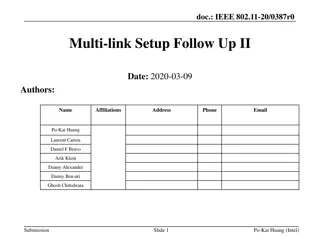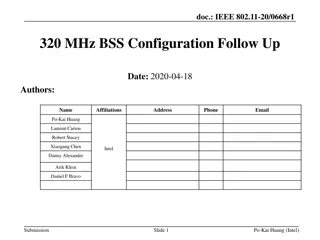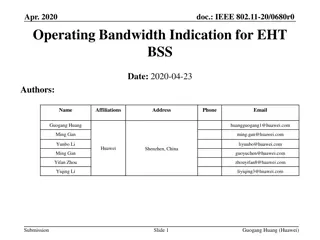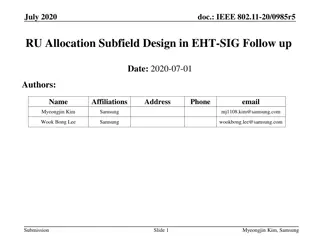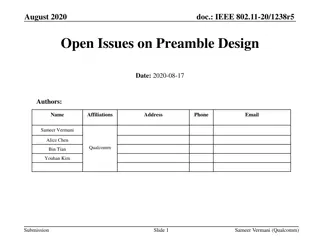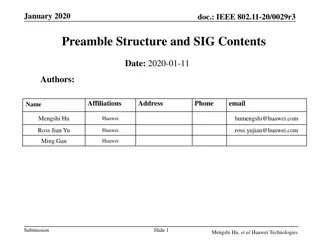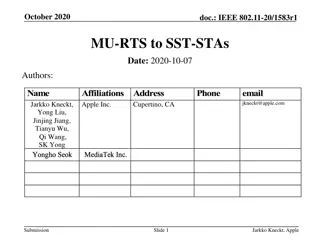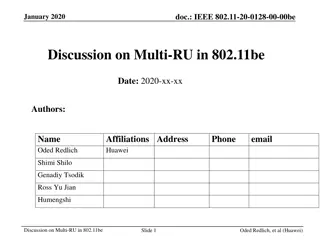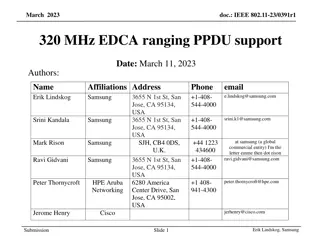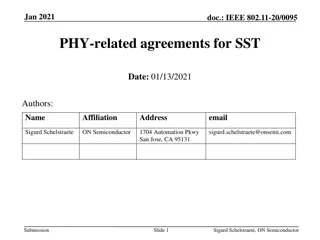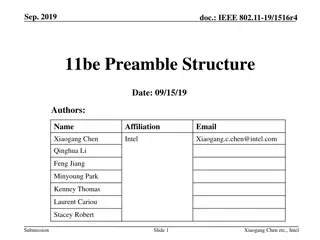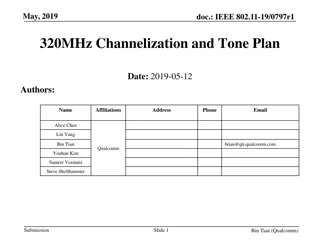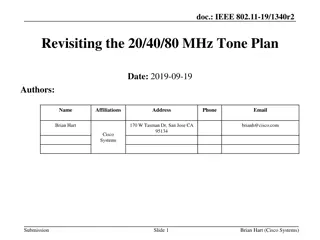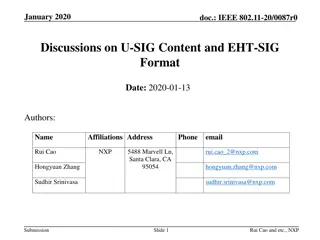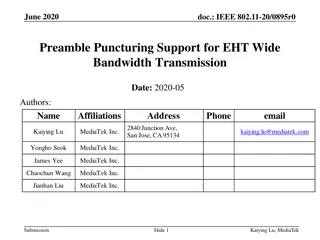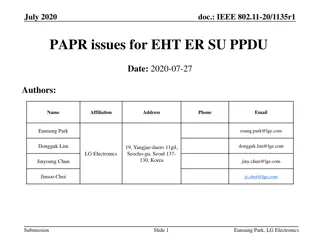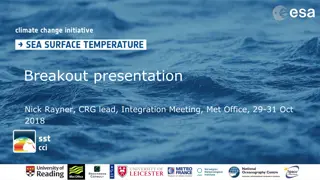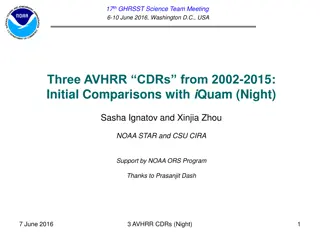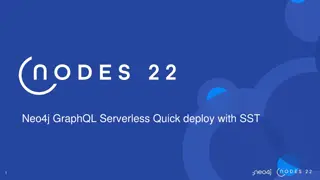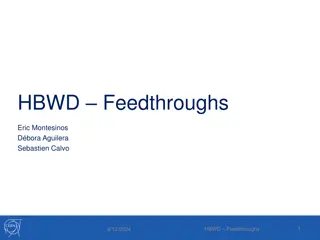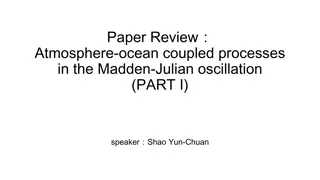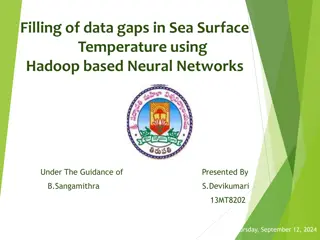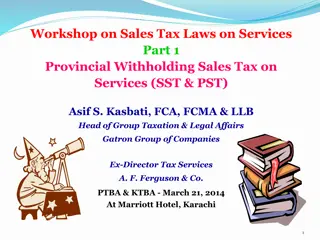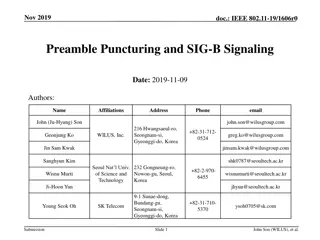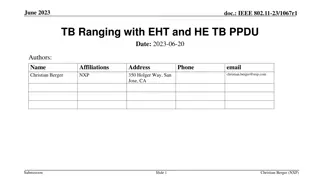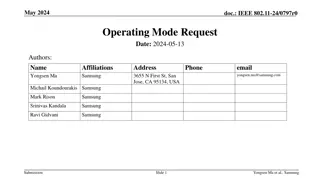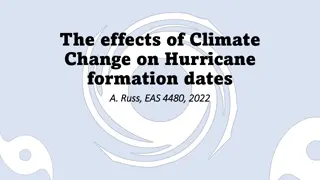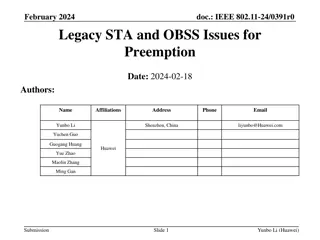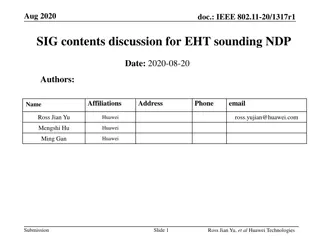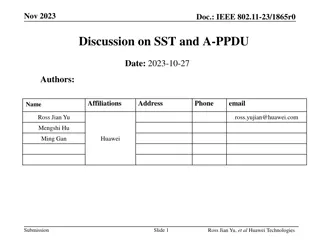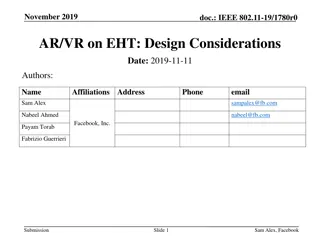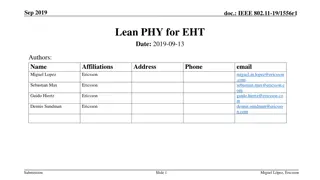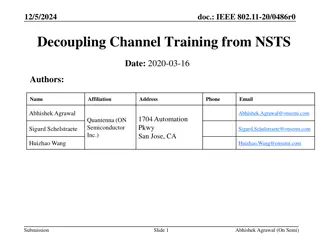Stochastic Storm Transposition in HEC-HMS: Modern Techniques and Applications
Explore the innovative methods and practical applications of Stochastic Storm Transposition (SST) in the context of HEC-HMS. Delve into the history, fundamentals, simulation procedures, and benefits of using SST for watershed-averaged precipitation frequency analysis. Learn about the non-parametric
3 views • 41 slides
Progress on IEEE 802.11 Multi-link Setup
Significant developments have been made in the multi-link setup within the IEEE 802.11 framework. The focus is on allowing only one STA in the MLD framework, differentiation with STA-level associations, and the rationale behind restricting to one STA. Proposals for defining multi-link devices and re
0 views • 12 slides
IEEE 802.11-20/0668r1: EHT BSS Configuration Proposal
The document discusses the configuration of a 320 MHz BSS in the context of 6 GHz regulations, focusing on EHT operation elements such as channel width indication, CCFS principles, and BSS advertisement settings. It proposes design principles for managing legacy and EHT STA operations, emphasizing s
0 views • 14 slides
Bandwidth Indication for EHT BSS in IEEE 802.11-20/0680r0
This IEEE document discusses the proposal to use an Enhanced High Throughput (EHT) operation element to indicate operating bandwidth for EHT Basic Service Sets (BSS). It suggests methods for indicating channel configurations, punctured channels, and channel width for EHT stations. The goal is to ena
0 views • 15 slides
Designing 9-Bit RU Allocation Subfield for EHT Trigger Frame in IEEE 802.11-20
IEEE 802.11-20/1845r2 presents a proposal for enhancing the RU allocation subfield design in the EHT Trigger frame to accommodate bandwidth support up to 320MHz and multiple RU or MRU allocations for UL MU transmissions in the 11be standard. The modification addresses inconsistencies in MRU mapping
0 views • 34 slides
IEEE 802.11-20/0985r5 RU Allocation Subfield Design in EHT-SIG
The document discusses the design of subfields in EHT-SIG for RU allocation in IEEE 802.11be, focusing on reducing overhead by considering supported large-size MRU combinations. It addresses concerns on entries overhead in the RU allocation subfield table and the clarity of support for specific MRU
3 views • 24 slides
IEEE 802.11-20/1238r5 August 2020 Preamble Design Open Issues
In these slides, designs for U-SIG content & overflow and EHT-SIG design are proposed. The focus is on punctured channel indication design with the aim of conveying puncturing patterns efficiently while keeping signaling overhead low. The proposal includes a 6-bit field for puncturing information, a
1 views • 41 slides
IEEE 802.11-20/0029r3 Preamble Structure and SIG Contents Overview
The document dated January 2020 discusses the preamble structure and SIG contents, focusing on EHT-SIG in IEEE 802.11-20/0029r3 amendment. It covers the introduction of U-SIG, EHT-SIG format, EHT.PPDU types, and EHT-SIG design for MU PPDU. The discussion includes the necessity of accommodating overf
3 views • 22 slides
IEEE 802.11-20/1583r1 MU-RTS and CTS Exchange Proposal
Submission outlines a proposal for exchanging Multi-User Request to Send (MU-RTS) and Clear to Send (CTS) frames with Enhanced High Throughput (EHT) Sub-Channel Selective (SST) STAs. It discusses channel signaling, frame transmission, proximity protection, operating bandwidth, and reservation proces
0 views • 18 slides
Discussion on Multi-RU Allocation in IEEE 802.11be Standard
In January 2020, a discussion took place on the allocation of multiple Resource Units (RUs) to a single Station (STA) in the IEEE 802.11be standard. The proposal suggested categorizing RUs into small and large types, avoiding aggregation across multiple 20MHz channels. It emphasized assigning a sing
2 views • 29 slides
Proposal for EHT 320 MHz PPDU Support in EDCA Ranging for IEEE 802.11-23/0391r1
The document outlines a proposal to enable EHT 320 MHz PPDU support for EDCA ranging in IEEE 802.11-23/0391r1. It discusses the implementation of FTM legacy ranging, the importance of wider bandwidths, and the necessary changes in the standard to incorporate this support. The proposal aims to enhanc
0 views • 6 slides
IEEE 802.11-20/0095 PHY-Related Agreements for SST
IEEE 802.11-20/0095 outlines agreements related to PHY aspects impacting the definition of Spatial Stream Tapping (SST) in 802.11 standards. The focus is on enabling 80 MHz operating stations to participate in 160 MHz OFDMA, including in non-primary 80 MHz scenarios. Various considerations and scena
1 views • 11 slides
IEEE 802.11-19/1516r4: 11be Preamble Structure Overview
The document discusses the design and structure of the 11be preamble in IEEE 802.11-19/1516r4. It emphasizes reusing existing functions from previous WiFi generations and focusing on features that enhance user experience. The preamble includes elements such as Pre-EHT preamble, EHT preamble, legacy
0 views • 13 slides
Channelization and Tone Plan Discussion for 320MHz EHT
IEEE 802.11-19/0797r1 discusses the channelization and tone plan design for 320MHz in EHT (11be). The slides cover the benefits of a 320MHz channel, double peak throughput, various BW modes, existing and new configurations, and proposals for tone plans to maximize efficiency. Detailed considerations
0 views • 10 slides
Revisiting the IEEE 802.11-19/1340r2 Tone Plan Optimization
Revisiting the tone plan optimization for IEEE 802.11-19/1340r2, addressing issues with RUs near band edges, accommodating various STA bandwidth capabilities, and the inefficiencies of non-SST 11ax STAs in different BSS scenarios. Proposals include adapting to unknown future 11ax features, minimizin
5 views • 12 slides
Comparison of Trigger-based vs. Non-Trigger-based Sensing Measurement in IEEE 802.11
The document discusses the differences between Trigger-based (TB) and Non-Trigger-based (Non-TB) sensing measurement instances in IEEE 802.11 standards, focusing on who initiates the sensing measurement. TB sensing is initiated by the AP, while Non-TB sensing is initiated by a non-AP STA, enabling o
6 views • 13 slides
IEEE 802.11-20/0087r0 Discussions on U-SIG Content and EHT-SIG Format
In January 2020, NXP presented a document discussing the U-SIG content and EHT-SIG format within the IEEE 802.11-20/0087r0 framework. The document elaborates on the structure and encoding of U-SIG fields, version-dependent and version-independent bits, as well as the EHT-SIG structure for SU/MU tran
0 views • 10 slides
Efficient Preamble Puncturing Support for IEEE 802.11 EHT Wide Bandwidth Transmission
The IEEE 802.11-20/0895r0 document addresses the introduction, issues, motivation, and support for preamble puncturing in EHT transmissions. It focuses on optimizing resource allocation while facilitating flexible preamble puncturing for OFDMA transmission in wide bandwidth scenarios, such as managi
0 views • 14 slides
PAPR Issues in EHT-ER-SU PPDU for 6GHz Wi-Fi Systems
Introduction of a new PPDU type (EHT-ER-SU) for extending transmission range in 6GHz Wi-Fi systems has led to PAPR issues due to frequency-duplicated data, impacting indoor and outdoor usage. Proposed methods aim to reduce PAPR, addressing concerns for indoor STAs and outdoor support in high-power s
0 views • 10 slides
Climate Research User Requirements and Product Specifications in Phase II SST CCI
User requirements for climate research in Phase II SST CCI were gathered through multiple methods including literature review, questionnaires, and workshops. These requirements were traced with unique identifiers and used to define product specifications for version 2.1 products in the Bridging Phas
0 views • 16 slides
Comparative Analysis of AVHRR SST Products and Matchups with iQuam
This document discusses the comparisons and analyses of several AVHRR SST products, such as Pathfinder V5.2 and CCI, with a focus on their matchups against iQuam using drifters and tropical moorings data. It covers biases, number of matchups, and mean bias values, providing insights into the perform
0 views • 24 slides
Simplified Serverless Stack Platform Deployment with SST
Streamline your serverless application deployment process with Serverless Stack Platform (SST). Easily configure, reference, and deploy AWS resources across different stacks. Take advantage of simplified authentication, high availability, scalability, and cost-effectiveness. Combine the best feature
0 views • 14 slides
Understanding SST and MTSS Processes in Education
SST and MTSS are frameworks used in education to address student needs through interventions and data-driven decision-making. The process involves assessing student data, matching interventions, involving parents, and monitoring progress. Classroom structures play a crucial role in implementing thes
0 views • 10 slides
Enhancing Support for Wider Bandwidth OFDMA in IEEE 802.11 Networks
The document discusses the implementation of Selective Spatial Transmission (SST) and Dynamic Subband Operation (DSO) to enable wider bandwidth OFDMA in IEEE 802.11be and 802.11bn standards. It covers enhancements for 80MHz, 160MHz, and 320MHz EHT DL and UL OFDMA transmissions, emphasizing the benef
0 views • 18 slides
Comprehensive Analysis of HBWD Feedthroughs Project
The HBWD Feedthroughs project involved contacting suppliers, receiving proposals, conducting simulations, and assessing offers for feedthrough specifications. Five suppliers were initially contacted, but only Kyocera and SST provided compliant offers. MDC's initial offer was non-compliant and is bei
0 views • 11 slides
Understanding Atmosphere-Ocean Coupling in Madden-Julian Oscillation
Atmosphere-ocean coupled processes in the Madden-Julian Oscillation (MJO) play a crucial role in intraseasonal oscillations. This paper review by Shao Yun-Chuan explores how the ocean's Sea Surface Temperature (SST) influences surface fluxes, MJO convection, and energy balance dynamics. It delves in
0 views • 17 slides
Enhancing Sea Surface Temperature Data Using Hadoop-Based Neural Networks
Large-scale sea surface temperature (SST) data are crucial for analyzing vast amounts of information, but face challenges such as data scale, system load, and noise. A Hadoop-based Backpropagation Neural Network framework processes SST data efficiently using a Backpropagation algorithm. The system p
2 views • 24 slides
Workshop on Sales Tax Laws on Services Part 1: Provincial Withholding Sales Tax on Services
This workshop conducted by Asif S. Kasbati covers topics such as Provincial Withholding Sales Tax in Sindh and Punjab, exemption and reduced rates in SST and PST, federal withholding sales tax, withholding agents, and the mechanism of withholding sales tax under SST and PST for different categories
0 views • 68 slides
Enhancing Spectrum Efficiency with Low Complexity Erasure Codes in IEEE 802.11 Document
This document delves into the implementation of erasure codes for content channels in IEEE 802.11 systems. By utilizing erasure codes, spectrum efficiency can be boosted without significantly increasing the complexity of encoding and decoding processes. The discussion also covers the duplication of
0 views • 20 slides
IEEE 802.11-19/1606r0 Preamble Puncturing and SIG-B Signaling
EHT, an enhancement to the IEEE 802.11 standard, aims to improve channel access in dense environments using wider bandwidth operation. This document discusses the design considerations for SIG-B content channels and preamble puncturing in the context of EHT's support for 320MHz bandwidth and multipl
0 views • 14 slides
IEEE 802.11-23/1067r1 TB Ranging with EHT and HE TB PPDU Overview
This document discusses the use of 320 MHz bandwidth in TB ranging for IEEE 802.11-23/1067r1, focusing on EHT and HE TB frames. It examines the decision trees regarding the use of EHT TB ranging NDP, limitations on frame mixing, and bandwidth reduction for Location Measurement Report (LMR). Key cons
0 views • 8 slides
IEEE 802.11-24/0797r0 Operating Mode Request
This document proposes an Operating Mode Request mechanism for STAs within the IEEE 802.11 standard. It allows a STA to request another STA to change its operating mode, such as bandwidth and number of spatial streams. The proposal outlines the reasons for making such requests and the acceptance/den
0 views • 10 slides
Impact of Rising Sea Surface Temperatures on Hurricane Behavior
Investigating the relationship between sea surface temperatures and hurricane behavior, focusing on the potential increase in out-of-season hurricanes with rising average SST. Data analysis from 1970-2020 reveals patterns in hurricane formation dates and categories, supporting the hypothesis of more
0 views • 13 slides
IEEE 802.11-15/1306r0 Use Cases for LRLP and Full Function in STA
The documents related to IEEE 802.11-15/1306r0 explore various use cases for LRLP (Low-Rate Longevity-Performance) and full functional capabilities in Single Terminal Architecture (STA). Tim Godfrey from EPRI presents scenarios where AP/STA pairings with 802.11ax and LRLP are approved and deployed,
0 views • 7 slides
Legacy STA and OBSS Preemption Considerations in IEEE 802.11-24
Discussions in IEEE 802.11-24 address preemption issues related to UHR STAs within a single BSS, focusing on legacy STA impact and OBSS considerations. Proposed solutions aim to balance efficiency and latency by adjusting TXOP limits for different STA types.
0 views • 7 slides
IEEE 802.11-20/1317r1 EHT-SIG Proposal Discussion
The document discusses EHT-SIG for single-user and sounding NDP in IEEE 802.11-20/1317r1, focusing on overflow bits, user fields, CRC, and tail formats. It covers the format details, subfields, and overhead compared to HE sounding, proposing specific bit allocations for different elements. The EHT-S
0 views • 16 slides
Discussion on IEEE 802.11-23/1865r0: SST and A-PPDU
The document discusses the current lack of support for SST on S160 in 11be, highlighting that 11be AP and STA do not support A-PPDU. It explores potential combinations for A-PPDU involving UHR and non-UHR HE and EHT STAs, addressing bandwidth enhancements and benefits of various scenarios. The analy
0 views • 14 slides
Design Considerations for AR/VR on EHT in IEEE 802.11-19/1780r0
Explore the detailed design considerations and use cases for AR/VR applications on EHT in the IEEE 802.11-19/1780r0 document. The document covers various aspects such as KPIs, timing diagrams, simulation results, comparisons with 5GNR, source of latency in 802.11, and suggestions for optimizing perf
0 views • 15 slides
Relevance of Lean PHY for EHT in 6 GHz
Discussing the importance of a Lean PHY for EHT in 6 GHz to improve spectrum efficiency and reduce overhead. Introducing the Low Throughput PHY as a potential solution, highlighting its benefits compared to existing options like 802.11a. Measurement results show the impact and potential for enhancin
0 views • 14 slides
Decoupling Channel Training Length for EHT Evaluation in IEEE 802.11 - 20/0486r0
Evaluation of decoupling channel training length from the number of streams for EHT in IEEE 802.11. The impact of noise on channel estimation error in data symbol detection is assessed, highlighting techniques for noise improvement. Further insights into 11ax training sequences are provided, along w
0 views • 13 slides

